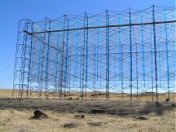



The blue nylon construction fabric on top of the scaffolding waves in the wind, the motion of the nearby Columbia River, as well as the surrounding grasses, echoed in its movement.
When I first heard about the Maryhill Double, an art installation/architectural piece, I knew that I had to visit it. The two artists/architects that created Maryhill Double, Annie Han and Daniel Mihalyo, who collectively operate as Lead Pencil Studio, had originally hoped to create their sculpture on the grounds of the Maryhill Museum of Art. The Maryhill decided not to invite Lead Pencil Studio to be part of their annual invitational sculpture "competition." Lead Pencil Studio instead were granted funding and built their piece on the other side of the Columbia River on private ranch land. The Maryhill Museum in Maryhill, Washington is mirrored by The Maryhill Double in Biggs, Oregon, with the two structures built on opposing cliff faces of the Columbia Gorge.
I was fascinated by the mirror image aspect of the Maryhill Double as well as the way that it "functioned" in its surroundings. The structure was built to take up the same amount of space and volume as the original Maryhill's shell. The interior floors and walls of the Maryhill were absent in the Double. All that remained was an exoskeleton of scaffolding and blue nylon construction fabric, held together with the help of construction wire and supported by guy wires. The interior floors and walls were provided by the imagination of the viewer. Two "stairwells" at opposite corners allowed one to climb to the levels of the "second floor," "third floor," and "roof."
I was unsure how long the wife and child were going to tolerate sitting and staring at this structure, so we took along a picnic lunch. This allowed me time to climb on the exterior, wander about the interior, and reflect upon the structure itself, all the while taking photographs while the two of them ate. We also spent time earlier in the day at the Maryhill Museum itself, and then reprised our visit after our time at the Maryhill Double. This allowed me to view the Double from the Maryhill and vice versa.
The space contained by the Double felt small to me once we were inside and eating our lunch. From the outside the Double felt much larger. I could easily imagine where the floors and the rooms of each floor were suppose to be, which made for some disconcertment as I tried to "find" my place in temporal space. I had a wonderful brief conversation with Annie Han, one of the artists/architects, on our way back to our car, parked a quarter-mile away. She inquired about our experience with the piece and I tried to elaborate on the "strangeness" of the size of the structure. She and I spoke about the fluctuation of space that occurs in the process of constructing a building—from foundation to framing to finishing—throughout the various stages. It was nice to have some of her insight into her project.
It was interesting to have this structure rising up out of a grassy field in the middle of nowhere, on a cliff face overlooking the Columbia, with any neighboring structures rather distant. This could describe the Maryhill Double or the Maryhill Museum itself. For me, an echo of the readymades of the Surrealists made itself known in the Double. The scaffolding and fabric felt as though it had been lifted from a construction site somewhere and randomly plopped down in the field. This made for another bout of disconcertment. It is amazing what we take for granted in the structures and spaces that we move about and within.
I am glad I made the trip. It was a worthwhile and enjoyable experience that will keep me pondering its ramifications for quite some time to come.

No comments:
Post a Comment